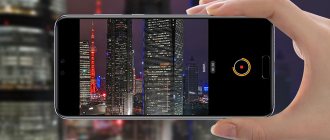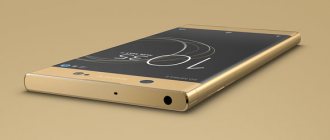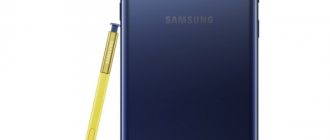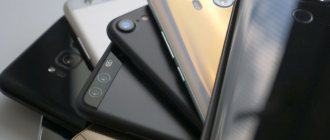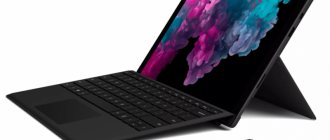Rating of phones with the best front selfie cameras
Today's smartphones already have their advantages in the field of cameras. In fact, in the future, the camera on a smartphone will be as advanced as a DSLR camera. Naturally, many manufacturers are competing to introduce smartphones with the best and highest quality cameras.
Today's smartphones already offer very powerful cameras located on the rear panel. But having a good front camera or selfie camera also forces manufacturers to take this parameter very seriously. Nowadays, many people are looking for phones with a quality front camera. The goal, of course, is to take good selfies.
We have compiled a ranking of mobile phones with the best front selfie cameras based on DxOMark tests.
The best inexpensive smartphones for selfies
To the surprise of some users, there are also inexpensive smartphones with a good selfie camera. The rating presents several devices almost from the budget category, but with good front modules.
Xiaomi Poco M3 4/64GB
In the ranking of the best smartphones for selfies in the budget category, POCO is one of the leaders in night photography. Such opportunities are provided by a 48 MP rear camera with a maximum aperture of F/1.79. The performance for a budget smartphone is impressive; the pictures come out pretty decent, with good detail. But it’s worth considering that they don’t reach flagship indicators. An affordable price is an advantage of the M3; from the technical side, it is a high-quality device, with good hardware, an extremely powerful battery and a large display built on an IPS matrix. Built-in memory of 64 GB is expandable up to 512 GB, RAM – 4 GB. The distinctive design of the smartphone makes it stand out from its analogues, and the corrugated surface and beveled edges make the smartphone convenient and completely non-marking. Among the disadvantages, users identified insufficient screen brightness, lack of NFC and a small selection of accessories on the domestic market.
Advantages:
- low price;
- good technical part and performance;
- 6000 mAh battery;
- fast charging function;
- decent stereo sound;
- The best camera system in its class.
Flaws:
- without NFC;
- small selection of accessories;
- The screen lacks a little brightness.
OPPO A53 4/64GB
The OPPO A53 is the top among inexpensive smartphones. It has an attractive design in cool colors, with soft tints on the back panel. The build quality is high - the smartphone is strong, but not very large and fits comfortably in the hands. The 6-inch frameless display with a high frequency of 90 Hz is comfortable for the eyes and does not tire you out when watching videos for a long time, surfing the Internet, or playing games. Photo capabilities are implemented by a triple rear camera, and you can take selfies with the front 8-megapixel camera located in the corner of the display. Despite the modest number of MP, the smartphone in tandem with Gcam takes good pictures in daylight, and numerous filters allow you to instantly process selfies and post them on social networks. But, according to reviews, the built-in AI does not always logically improve pictures.
Advantages:
- stereo speakers;
- NFC;
- fast Snapdragon 460 chipset from Qualcomm;
- high sweep frequency;
- capacious battery;
- justified price tag.
Flaws:
- AI image processing is not always useful.
realme 6S 6/128GB
An inexpensive smartphone with a good front camera and a modern system of four main cameras conveys landscapes as realistically as possible and takes high-quality interior and artistic photography. At the same time, the quad camera is not demanding on lighting, and the selfie module is equipped with a lot of functions and an algorithm for individual image processing. In addition to decent frames, the smartphone has a powerful battery and a fast processor. Thanks to the unique App Quick Freeze technology, the device is not prone to heating and pleases with smooth operation without freezing. Industrial design guru Naoto Fukasawa worked on the appearance of the smartphone, so it can safely be called unique. When choosing a high-quality and practical selfie device, the 6S will be a good purchase in 2021. Like no other, he combined ingenious design and the best technologies in the budget segment.
Advantages:
- functional front camera;
- unique design;
- pleasant sound;
- decent amount of memory;
- efficient cooling system;
- large 90Hz display.
Flaws:
- no event indicator.
Huawei P40 Pro
- Release: April 2021
- Screen: OLED 6.58 inches, 1200 x 2640 pixels
- Chipset : HiSilicon Kirin 990 5G (7nm+)
- GPU: Mali-G76 MP16
- RAM: 8 GB
- Internal memory: 128 GB, 256 GB, 512 GB
- External memory: up to 256 GB
- Main camera: 50MP + 12MP + 40MP + 3D TOF camera
- Front camera: 32 MP + IR TOF 3D
- Battery: Non-removable Li-Po 4200 mAh
Currently, DxOMark has named the Huawei P40 Pro as the world's best camera phone for selfies with a score of 103. The rear camera also records impressive results with a score of 128 (140 for photos and 105 for videos). This makes it the best camera phone in the world according to DxOMark (as of 05/14/2020).
Huawei has equipped this smartphone with two front cameras. One of them is a 32MP wide-angle sensor with f/2.2 aperture. The other is a 3D IR sensor for depth estimation and autofocus. The front camera is capable of recording videos in Full HD and 4K format.
According to DxOMark, the camera's selfies have excellent detail indoors and outdoors, white balance is generally accurate, and skin tones are pleasing to the eye. A number of positive reviews also come from the quality of the video. So, the front camera can be relied upon not only for selfies but also for those who like to vlog.
#9 – Xiaomi Redmi S2
Price: 10,180 rubles
Ninth place in our ranking of front cameras goes to Xiaomi Redmi S2. The smartphone has a 16-megapixel sensor as a selfie camera. It can take wide-angle shots as well as portrait mode. I would also like to note the presence of image stabilization when recording video. This technology cannot be found in every more expensive device, so its presence in a budget device evokes respect for Chinese engineers.
The advantages of the model include the presence of a dedicated slot for microSD flash drives with a capacity of up to 256 GB. Well, the Chinese succeeded in oleophobic coating of the display with a 5.99-inch diagonal and a resolution of 1440 by 720 pixels. In addition, the screen has bright and rich colors, as well as maximum viewing angles. As for the negative aspects, the gadget does not support dual-band Wi-Fi and does not have an NFC module.
Xiaomi Redmi S2
Huawei nova 6 5G
- Screen: 6.57 inch LTPS IPS LCD
- Screen resolution: 1080 x 2400 pixels
- Chipset: HiSilicon Kirin 990 (7 nm)
- Processor: Octa-core (2 × 2.86 GHz Cortex-A76 and 2 × 2.09 GHz Cortex-A76 and 4 × 1.86 GHz Cortex-A55)
- GPU: Mali-G76 MP16
- Internal memory: 128 GB 8 GB RAM, 256 GB 8 GB RAM
- External memory: no
- Main camera: triple 40 MP + 8 MP + 8 MP
- Front camera: dual 32 MP + 8 MP
- Battery: Non-removable Li-Po 4200 mAh
DxOMark ranks Huawei nova 6 5G as one of the phones with the best selfie camera. This mobile phone has a very good overall score of 100 (105 for photos and 93 for videos).
The nova 6 5G selfie camera has accurate target exposure, good skin tone reproduction, good detail in most conditions, low image noise. A photo taken with active flash also has the same quality.
With a score of 93 for video, the results from this front camera may not be the best. But the quality is definitely one of the best on this list, with good illumination in bright light and indoors.
Pixel 3
And finally, the best selfie phone at the beginning of 2021 according to DxOMark. At the moment, this is the only smartphone in which the main camera is represented by one lens, while the front camera consists of two. These are two 8-megapixel Sony IMX353 modules, one main, the other wide-angle. The result is both excellent portraits and high-quality group selfies. There is also a bokeh effect. Both lenses automatically shoot in HDR mode, one of the cameras is capable of Full HD shooting at 30 frames per second.
These were the best selfie phones of 2021,
SUBSCRIBE to our telegram channel .
If you find an error, please select a piece of text and press Ctrl+Enter.
Samsung Galaxy S20 Ultra
- Release: February 2021
- Screen: Dynamic AMOLED 2X6.9 inches, 1440 x 3200 pixels
- Chipset : Exynos 990
- GPU: Mali-G77 MP11
- RAM: 12 GB, 16 GB
- Internal memory: 128 GB
- External memory: microSD up to 1 TB
- Main camera: 108 MP + 48 MP + 12 MP + 0.3 MP
- Front camera: 40 MP
- Battery: Non-removable, Li-Po 5000 mAh
Introducing a 40MP selfie camera, the Samsung Galaxy S20 Ultra makes no mistake in being called one of the best selfie-capable mobile phones.
In DXOMARK tests, this mobile phone scored 100 with some of its basic capabilities in exposure and color display.
When shooting outdoors and during daytime, the camera is able to activate precise autofocus at any distance. Meanwhile, this selfie lens can also provide good distinction between the photo subject and the background, creating a bokeh effect that looks amazing.
iPhone XS Max
Like its predecessors, the XS Max received a 7-megapixel front camera with f/2.2 aperture. It has been improved and received new features. It is based on Apple TrueDepth technology.
Thus, selfies have more depth and sharpness in portrait mode, and the bokeh effect has also been improved. In addition, the smartphone was one of the first to have a front camera with an HDR mode for video. Moreover, stabilization has appeared and there is an Apple Retina flash, which can be used in low light conditions.
Samsung Galaxy Note 10+ 5G
- Screen: Dynamic AMOLED 6.8 inches
- Screen resolution: 1440 x 3040 pixels
- Chipset: Exynos 9825 (7 nm) / Qualcomm SM8150 Snapdragon 855 (7 nm)
- Processor: Octa-core (2 × 2.73 GHz Mongoose M4 and 2 × 2.4 GHz Cortex-A75 and 4 × 1.9 GHz Cortex-A55) / Octa-core (1 × 2.84 GHz Kryo 485 and 3 × 2.42 GHz Kryo 485 and 4 × 1.78 GHz Kryo 485)
- GPU: Mali-G76 MP12/Adreno 640
- Internal memory: 256 GB 12 GB RAM, 512 GB 12 GB RAM
- External memory: microSD, up to 1 TB (dedicated slot)
- Main camera: Quad 12 MP + 12 MP + 16 MP + TOF 3D VGA
- Front camera: 10 MP, f/2.2, 26mm (wide), 1/3″, 1.22µm, Dual Pixel PDAF
- Battery: Non-removable Li-Po 4300 mAh
This device is available in a number of countries that have adopted 5G technology. The Samsung Galaxy Note 10+ 5G is a high-end mobile phone at a fairly high price, so it certainly has excellent features, including in terms of image processing.
The front camera capabilities of this smartphone are among the best in the world. The overall DxOMark score achieved by this mobile for the front camera is 99, 103 for photos and 93 for videos.
The pros of this selfie camera are that it has accurate target exposure and wide dynamic range, good white balance in bright and indoor lighting, bokeh effects and good detail.
Meanwhile, photos taken with the flash on are also well lit. With a score of 93, the video quality is rated on par with other mobile phones on this list with the same score.
No. 3 – Xiaomi Mi Mix 3
Price: 31,000 rubles
Xiaomi Mi Mix 3 is a smartphone with a slider form factor body. In 2018-2019, such a solution looks, at least, unusual, so engineers from China want to give a plus for such a bold step. The 6.39-inch display with a resolution of 2340 by 1080 pixels has minimal bezels. It performs well in its work – the colors are saturated and do not fade when tilted. The maximum display brightness is 600 nits, which is average. For Apple's top flagships, the same value is 800-900 nits.
Due to the unusual form factor, the case will be weighty, even in comparison with the grandee Samsung Galaxy S9 - 218 versus 163 grams. True, this only makes the smartphone look solid and premium. The front camera consists of two sensors - the first with a resolution of 24 MP acts as the main one, and the second 2-megapixel is needed for portrait shots. Bokeh mode produces smooth blur and attention to detail. During normal shooting, in almost any lighting, you can get an image with a wide dynamic range, but this result is easiest to achieve during the day.
Xiaomi Mi Mix 3
Samsung Galaxy S10 5G
- Chipset: Exynos 9820 Octa (8 nm)
- RAM and storage: 8 GB and 256 GB
- Camera: Quad 12MP + 12MP + 16MP + TOF camera
- Battery: Li-Ion 4500 mAh
This mobile phone has a pretty attractive front camera. Because the front camera comes with an additional TOF camera.
The front camera has a 10 MP sensor and offers Dual Pixel PDAF. The front camera also supports Dual video call and Auto-HDR functions. The selfie camera supports video recording up to 2160 pixels at 30 frames per second.
In DxOMark tests, the front camera received a score of 97, which is slightly lower than the Asus Zenfone 6. Apart from the excellent front camera performance, this mobile phone also offers a good rear camera. This mobile phone has four rear cameras namely 12MP wide-angle camera, 12MP telephoto camera, 16MP ultra-wide camera and TOF camera.
Samsung Galaxy A71 6/128GB
A mid-budget model with a front-facing camera, which on paper looks like a flagship.
| Options | |
| Display | 6.7”, Super AMOLED (FullHD+) |
| Rear camera | 64MP + 12MP + 5MP + 5MP |
| Frontal | 32MP |
| CPU | Snapdragon 730 |
| Battery | 4500 mAh |
In practice, the Galaxy A71's selfie camera also shows good results, but it definitely doesn't reach the flagship level. The user is forced to make concessions when choosing the optimal lighting for shooting.
Pros:
- rear camera quality;
- stable shell;
- autonomy.
Minuses:
- Samsung's photo algorithms are inferior to competitors.
Samsung Galaxy S10 Plus
- Chipset : Exynos 9820 Octa (8 nm)
- RAM and storage : 16px;»>: 8 GB and 512 GB
- Camera : Triple 12 MP + 12 MP + 16 MP
- Battery : Li-ion 4100 mAh
The Samsung Galaxy S10 Plus or Samsung Galaxy S10+ competes with its siblings namely the Samsung Galaxy S10 5G as the mobile phone with the best selfie camera. Why not, the score of 96 given by DxOMark makes this mobile phone worthy of taking the top spot among mobile phones with the best selfie camera.
96 points scored by this mobile phone with the presence of two front cameras on this phone. The first camera of this mobile phone has a 10MP camera with f/1.9 aperture and supports Dual Pixel PDAF. The second camera is an 8-megapixel f/2.2 camera that doubles as a depth sensor.
The front camera of this mobile phone supports LED flash, auto-HDR and panorama features. In terms of video recording, the front camera can record HDR videos and supports recording up to 2160 pixels at 60 fps.
#5 – Samsung Galaxy A7 (2018)
Price: 21,890 rubles
Samsung Galaxy A7 (2018) is one of the few smartphones that allows you to simultaneously use two SIM cards and a memory card with a capacity of up to 512 GB. The 6-inch display with a resolution of 2220 by 1080 pixels is made using AMOLED technology, so the image on it always has natural color reproduction and is not distorted from any angle.
The smartphone has a single 24-megapixel sensor on the front. It takes excellent pictures - in daylight you can get detailed photos with the correct color balance, but in the dark you are unlikely to get a sane result. But the front camera has a wide range of different effects, and also allows you to create your own set of icons for instant messengers (selfiemoji). Therefore, if you spend a lot of time on social networks, then you will definitely like this model.
Samsung Galaxy A7
Huawei Mate 30 Pro
- Screen: 6.53 inches OLED
- Screen resolution: 1176 x 2400 pixels
- Chipset: HiSilicon Kirin 990 (7nm+)
- Processor: Octa-core (2 × 2.86 GHz Cortex-A76 and 2 × 2.09 GHz Cortex-A76 and 4 × 1.86 GHz Cortex-A55)
- GPU: Mali-G76 MP16
- Internal memory: 256 GB 8 GB RAM
- External Memory: NM (Nano Memory), up to 256 GB (shared SIM card slot)
- Main camera: Quad 40 MP + 8 MP + 40 MP + 3D TOF
- Front camera: dual 32 MP + 3D TOF
- Battery: Non-removable Li-Po 4500 mAh
The front camera of this mobile phone is capable of taking good selfies with a DxOMark score of 97 points, but the recording quality is a few points lower, so the overall score for the Huawei Mate 30 Pro selfie camera is 93.
DxOMark explains that the Mate 30 Pro's front-facing camera results have fairly wide dynamic range, accurate target exposure on faces and good detail in all conditions, good indoor and outdoor noise control, and good exposure and color in use.
Key features of the footage include accurate targeted exposure on faces and wide dynamic range, quick exposure adaptation in changing scenes, well-controlled noise in all conditions, and good skin tone rendition in most conditions.
Budget models
In inexpensive smartphones, as a rule, the emphasis is on one of the functions to the detriment of others, so even if you have a good front camera, in parallel there may be a weak processor, a microUSB port, the presence of near-screen frames, and a weak battery.
Meizu Note 9 – good photo capabilities
Meizu Note 9.
2021 model with a budget combination of typical design and a set of options. In addition to the main dual camera with 40 megapixel main optics, the phone has a 20 megapixel selfie camera with 2.0 aperture. In daylight, the photo quality is not satisfactory; the resolution, brightness level, contrast, and detail are at an acceptable level. Night photography corresponds to the price of the device - artifacts and dark areas are noticeable in the pictures. The standard camera application offers a basic set of functions and visual effects.
With good photo capabilities, Meizu Note 9 offers a high-performance Snapdragon 675 chipset from Qualcomm, which provides smooth graphics at medium settings in “heavy” games. The 4000 mAh battery will last for a whole day of selfies, up to 5.5 hours of gaming.
Advantages:
- 6.22-inch IPS screen supporting FHD+ resolution;
- powerful processor;
- battery life;
- bright body made of composite plastic;
Flaws:
- rear panel is easily soiled.
ZTE Blade V10 – cool camera
ZTE Blade V10 has a well-made body.
The ZTE Blade V10 has a 32-megapixel front camera with an F2.0 aperture with a large selection of shooting modes. The selfie camera captures the best of some of the main cameras of competitors in the segment. The model has a well-implemented beauty function, which can be disabled if desired by setting the value to zero. There is also a portrait mode in which photography takes place with a blurred background. Contours are processed at a high level, despite the absence of an additional depth sensor.
Photos look great on a high-quality 6.3-inch screen with FHD+ resolution, housed in a compact body. The MediaTek Helio P70 processor is economical and yet has high performance, sufficient to run modern games. In offline mode, the ZTE Blade V10 can last for a day.
Advantages:
- USB Type-C;
- wired headphone jack;
- NFC contactless payment;
- selection of manual settings.
Flaws:
- easily soiled body;
- speed of the fingerprint scanner.
Honor 10i - triple lens
Honor 10i is a smartphone with three cameras.
A smartphone with balanced characteristics and advanced photo capabilities. The main photo module consists of three 24+8+2 megapixel sensors. You can take photographs with the main camera both during the day and in the dark - the quality of the image is not critically affected by the level of lighting. The 32MP front camera with f/2.0 aperture captures stunning photos with vibrant, rich colors. The user has access to a wide selection of filters that allow him to improve pictures for subsequent publication on social networks.
Honor 10i has a 6-22 inch IPS screen with FHD+ resolution. The top of the display is covered with impact-resistant Corning Gorilla Glass 3 with a 2.5D effect. The smartphone is powered by an eight-core Kirin 710 processor, a Mali-G51 MP4 video accelerator, 4 GB of RAM, 128 internal memory. Such parameters make it easy to cope with modern tasks.
Advantages:
- gradient body color;
- capacious battery;
- NFC support;
- The front camera is hidden in a compact teardrop-shaped cutout.
Flaws:
- poor oleophobic coating on the rear panel;
- microUSB connector;
- lies uncomfortably in the hand;
- no LED event indicator
Honor 10 review ►
Apple iPhone 11 Pro Max
- Release: September 2021
- Screen: Super Retina XDR OLED 6.5 inches, 1242 x 2688 pixels
- Chipset : Apple A13 Bionic (7nm+)
- GPU: Apple GPU (4-core graphics)
- RAM: 4 GB
- Internal memory: 64/256 GB/512 GB
- External memory: —
- Main camera: 12 MP + 12 MP + 12 MP
- Front camera: 12 MP + SL 3D
- Battery: Non-removable Li-Ion 3969 mAh
This Apple flagship phone was also able to score high for selfies, namely 92 points (93 points for photos and 90 points for videos). With the excellent setup of the dual front camera, you can be sure that the capabilities of this front camera are very high.
According to DxOMark, the colors in iPhone 11 Pro Max selfie photos are cheerful and vibrant, especially outdoors. In addition, the photo also has accurate exposure with a wide dynamic range. Fine details of the face are also shown in the close-up shot.
Meanwhile, video quality up to 4K ensures effective stabilization, as well as good face focusing and depth of field. In addition, the video also shows accurate exposure with wide dynamic range and colors that are beautiful to look at with accurate white balance.
#6 – Sony Xperia XA2 Ultra
Price: 20,880 rubles
The Sony Xperia XA2 Ultra is content with sixth place in our top budget phones with a good front camera. Due to the aluminum body and signature angular design, the smartphone looks original and expensive. This effect is achieved thanks to a 6-inch matrix with a resolution of 1920 by 1080 pixels - the frames around it are minimal, and the image is always replete with bright and rich colors.
The front camera in the Sony Xperia XA2 Ultra is double. The first 16-megapixel module is equipped with autofocus and optical stabilization, and the second is wide-angle with a viewing angle of 1200. This set allows you to take good photographs during the day. They have accurate white balance, correct backlighting, and a fairly wide dynamic range. As lighting decreases, artifacts appear and sharpness drops significantly. The negative side of the model is the fragile back panel made of plastic, which is easily scratched.
Sony Xperia XA2 Ultra
Google Pixel 4
- Screen: 5.7-inch P-OLED
- Chipset: Qualcomm SM8150 Snapdragon 855 (7 nm)
- Processor: Octa-core (1 × 2.84 GHz Kryo 485 and 3 × 2.42 GHz Kryo 485 and 4 × 1.78 GHz Kryo 485)
- GPU: Adreno 640
- Internal memory: 64 GB 6 GB RAM, 128 GB 6 GB RAM
- External memory: no
- Main camera: dual 12.2 MP + 16 MP
- Front Camera: Dual 32MP, f/2.0, 26mm (wide), 1/2.8″, 0.8µm + TOF camera
- Battery: Non-removable Li-Po 2800 mAh
The selfie camera capabilities of Google Pixel 4 are not much different from its predecessor Google Pixel 3, although this mobile phone has a dual front camera. The Pixel 4's selfie camera has a DxOMark score of 93 for photos and 91 for video.
This HP selfie camera is capable of capturing photos with good colors and natural skin tones. In addition, it has a wide dynamic range in bright conditions.
In terms of video quality, DxOMark says the stabilization works very effectively, with good levels of detail and accurate target exposure on the face.
#5 – Honor Play
Price: 19,990 rubles
Honor Play was created as a mobile phone for gamers; this is supported by the presence of a Kirin 970 processor in the smartphone, which is sufficient for all modern games, as well as special GPU Turbo technology, which reduces system power consumption by a third and increases its performance by 60%. It really works and allows you to play projects such as World Of Tanks and PUBG at maximum settings with a comfortable FPS. However, with this usage scenario, the body of the gadget heats up noticeably.
The front camera of the smartphone is a 16-megapixel sensor with F/2.0 aperture. In the presence of daylight, it shows good results - the images have a wide dynamic range, correct color balance and natural color rendition. With a lack of lighting, the situation deteriorates, but not so critically. Therefore, we strongly recommend this model for users who like to play games and take selfies. In terms of price-quality ratio, this is one of the best offers on the market.
Honor Play
Samsung Galaxy Note 9
- Chipset : Exynos 9810 Octa (10 nm)
- RAM and storage: 16px;»>: 8 GB and 512 GB
- Camera : Dual 12 MP + 12 MP
- Battery : Li-Ion 4000 mAh
The Samsung Galaxy Note 9 has a front camera, which is also of good quality. Just like the Google Pixel 3, this mobile phone gets a DxOMark score of 92. So, for the front camera, we can say that the camera quality of Samsung Galaxy Note 9 is balanced with Google Pixel 3.
The front camera itself of the Samsung Galaxy Note 9 has an 8MP wide-angle camera. This camera has an f/1.7 aperture, supports autofocus and auto HDR. The 8 MP front camera itself is capable of providing high-quality selfie photos with accuracy and good bokeh photo effects.
Thanks to the excellent quality of the front camera, this makes the Samsung Galaxy Note 9 suitable not only for productivity but also for taking photos from both the front and rear cameras.
Pixel 2
And here is another flagship of 2021 among the best selfie phones according to DxOMark, only this time from Google. Compared to the Pixel 2's main camera, its front-facing camera is simpler. But despite this, it works flawlessly and gives impressive results. This is an 8 megapixel module with f/2.4 aperture.
The camera software makes it possible to take selfies with a bokeh effect. In addition, these same algorithms make portrait mode available. There is also an HDR+ mode and integration with neural networks, using which you can create unique selfies.
Huawei P30 Pro
- Chipset : HiSilicon Kirin 980 (7 nm)
- RAM and storage : 8 GB and 128 GB
- Camera : Quad 40MP + 20MP + 8MP + 3D TOF camera
- Battery : Li-Po 4200 mAh
Huawei P30 Pro is another good phone with a front camera. This mobile phone has received a DxO Mark score of 89 for its front camera. This result suggests that Huawei P30 Pro is not at the top, unlike the rear camera. In the rear camera category, Huawei P30 Pro is in the top positions.
The score received by the Huawei P30 Pro is actually quite good. The reason is that this phone only has one front camera. The camera has a 32-megapixel sensor with f/2.0 apertures. The camera is equipped with HDR capabilities and is capable of recording video up to 1080p at 30 frames per second.
A mobile phone with one of the best rear camera phones. This is evidenced by the DxOMark HP score, which reaches 112 points. The score is definitely high, so this mobile phone is definitely worth considering for purchase.
Rules for choosing a phone for selfies
When choosing a phone for selfies, the first thing you should pay attention to is resolution. To take high-quality portrait photographs, this figure must be more than 12 megapixels. In addition, it is also recommended to focus on the megapixel size. This indicator must exceed 1 micron.
It is best to choose smartphones equipped with multiple front cameras. They will allow you to take high-quality pictures in any conditions. It should be taken into account that the dual selfie camera module increases its cost.
Another point that you should pay attention to when purchasing a device is the aperture performance. The bigger they are, the better. The fact is that it is a wide aperture that will allow you to take good quality photographs in different lighting conditions. It is best to choose phones with an f1.9 indicator.
Another important point is the presence of optical stabilization. If you have one, you don’t need to worry that shaking hands will ruin the quality of the photo.
Choose a phone with a camera resolution greater than 12 megapixels
Let's summarize which phone with a good selfie camera is best to choose. It is recommended to focus on the characteristics of the models and the size of the budget. If you need a device at an affordable price, pay attention to the Honor 8A model. From the mid-price segment, we can recommend the Xiaomi Mi A3. The best flagship with an excellent selfie camera is the Apple iPhone 11. You can choose another suitable model from our rating.
OnePlus 7 Pro
- Chipset : Qualcomm SDM 855 Snapdragon 855 (7 nm)
- RAM and storage : 6 GB and 128 GB or 8/12 GB and 256 GB
- Camera : Triple 48 MP + 8 MP + 16 MP
- Battery : Li-Po 4000 mAh
HP's front-facing camera scores 86 based on the DxOMark test. This is a good result considering that the front camera of the OnePlus 7 Pro is just a single lens with a 16 MP sensor.
The front camera of this mobile phone has f/2.0, Auto-HDR feature. For video recording, this camera only offers recording up to 1080p 30fps. But the front camera already has EIS gyroscope function.
#7 – Huawei P20 Lite
Price: 16,390 rubles
Huawei P20 Lite is an excellent solution for geeks and other advanced users. Firstly, this is supported by the presence of all modern features in the gadget, from the NFC module to the stable face unlock technology. Secondly, the firmware is equipped with tools with which each user can configure the smartphone as it suits him, including editing the color temperature of the 5.84-inch display, hiding or leaving bangs, and choosing the way applications are presented.
The smartphone's hardware platform is excellent - the Kirin 659 chipset and 4 GB of RAM are enough for any task. The main advantage of the model is the 8-megapixel front camera with F/2.0 aperture. She can take really high-quality and clear photos, and even without the right lighting she can produce good results. As for the downsides, the body of the gadget is too slippery.
Huawei P20 Lite
Honor 20 Pro
- Screen: 6.26 inches IPS LCD
- Chipset: HiSilicon Kirin 980 (7 nm)
- Processor: Octa-core (2 × 2.6 GHz Cortex-A76 and 2 × 1.92 GHz Cortex-A76 and 4 × 1.8 GHz Cortex-A55)
- GPU: Mali-G76 MP10
- Internal memory: 128 GB 8 GB RAM, 256 GB 8 GB RAM
- External memory: no
- Main camera: Quad 48 MP + 8 MP + 16 MP + 2 MP
- Front camera: 32 MP, f/2.0, 26mm (wide), 1/2.8″, 0.8µm
- Battery: Non-removable Li-Po 4000 mAh
The Honor 20 Pro smartphone is equipped with a selfie camera with good capabilities. The DxOMark score for this HP front-facing camera is 85 for both photo and video quality.
The selfie camera on the Honor 20 Pro has white balance in all conditions. Meanwhile, the camera is also capable of taking photos with accurate lighting in all conditions, as well as with the flash on.
The resulting photo also has noise, which is well controlled when taking selfies in low light conditions. The recordings were produced to the same quality, so the final scores were the same for both measures.
iPhone X
In terms of its characteristics, the front camera of the iPhone X is not much different from its predecessors. This is a 7-megapixel camera with f/2.2 aperture. But, nevertheless, there were some improvements. It received Face ID technology, which is a more advanced system of sensors and modules. For example, an infrared camera, a dot projector, an infrared emitter.
Plus, it's all powered by the A11 Bionic processor. To be more precise, a special neural core is responsible for the operation of the front camera. As a result, the front camera is able to more clearly determine the contours and features of the face. This in turn opens up the possibility of taking selfies in portrait mode using portrait lighting. Moreover, Animoji appeared.
Asus Zenfone 6 ZS630KL
- Snapdragon 855
- RAM and storage : 6/64 GB, 64/128 GB, 8/256 GB
- Camera : Dual 48 MP + 13 MP
- Battery : Li-Po 5000 mAh
Asus Zenfone 6 is a mobile phone with one of the best selfie camera. DxOMark gave this mobile phone a score of 98, certainly a high score, and places it high in the rankings. The front camera score of this mobile phone also actually confirms that the front camera of this mobile phone can have the same score as the back camera. For what?
This is because the Asus Zenfone 6 has a rotating flip camera system that can also be used for both the front and rear cameras. This flip-up camera itself is equipped with a dual camera.
The first camera of this mobile phone is a 48MP f/1.6 camera. This camera uses Sony IMX586 sensor, a 48MP sensor. The second camera is a 13MP ultra-wide-angle camera. This ultra-wide-angle camera has an f/2.4 aperture and an 11mm focal length.
Which mobile phone with the best selfie cameras should you choose? Whatever you choose, keep in mind that smartphones tend to be high-end phones and therefore don't come cheap.
comparison table
| Name | Display size (inch) | Battery capacity (mAh) | RAM (GB) | Internal memory (GB) | Camera resolution (MP) | Average price (RUB) |
| Xiaomi Redmi Note 10 Pro | 6,67 | 5020 | 8 | 128 | 108+8+5+2 | 26000 |
| Samsung Galaxy A52 | 6,5 | 4500 | 4 | 128 | 64+12+5+5 | 27500 |
| Xiaomi Mi 11 Lite | 6,55 | 4250 | 6 | 128 | 64+8+5 | 26800 |
| Samsung Galaxy A72 | 6,7 | 5000 | 6 | 128 | 64+12+8+5 | 32990 |
| Xiaomi POCO X3 Pro | 6,67 | 5160 | 8 | 256 | 48+8+2+2 | 26000 |
| realme 8 Pro | 6,4 | 4500 | 8 | 128 | 108+8+2+2 | 27990 |
| Xiaomi POCO F3 | 6,67 | 4520 | 6 | 128 | 48+8+5 | 26900 |
| OnePlus 8 | 6,55 | 4300 | 8 | 128 | 48+16+2 | 30990 |
| Nokia X20 | 6,67 | 4470 | 8 | 128 | 64+5+2+2 | 29950 |
Xiaomi Mi 11 Ultra
- Main camera: 50 MP + 48 MP + 48 MP
- Front camera: 20 MP
This model has one of the best cameras in its class and even tops the DxOMark rating. Mi 11 Ultra received a triple module with a main sensor from Samsung with a resolution of 50 megapixels and 10x hybrid zoom, a 48 megapixel wide lens and a 48 megapixel telephoto module with 5x optical zoom. The gadget can record video in 8K, supports laser autofocus and generally shoots with a zoom of up to x120.
Also in the camera block there is a 1.1-inch additional AMOLED display, which duplicates the main screen - you can display notifications, previews when taking selfies, or your own screensaver.
The model runs on the top Qualcomm Snapdragon 888 processor, supports fast charging up to 67 W, HDR10+ extended dynamic range and a frame refresh rate of 120 Hz. The screen, by the way, is quite large and bright - an AMOLED matrix with a diagonal of 6.81 inches. The smartphone is also protected from water and dust according to the IP68 standard.
Middle price segment
Mid-range selfie phones are a balanced smartphone that can be fully used not only in camera mode, but also solve a wide range of tasks.
Motorola Moto G8 Plus – the hero of the mid-range segment
Motorola Moto G8 Plus.
Motorola Moto G8 Plus is a medium-sized smartphone with rounded corners. It features a 6.3-inch IPS display with FHD+ resolution. The phone is equipped with an eight-core Qualcomm Snapdragon 665 processor with an Adreno 610 video accelerator, 4 GB of RAM.
The main 48 megapixel lens with laser autofocus is based on Quad Pixel technology. This solution allows you to increase light sensitivity in night shooting conditions. The quality of photos with the stock camera application is not up to par with flagships, but if you wish, you can install Google Camera, which will significantly improve the quality of the final result. The 25-megapixel front camera has an increased pixel size and an f/2.0 aperture. The pictures come out quite good, but require further refinement in a photo editor to get the perfect selfie.
Advantages:
- pure Android;
- NFC;
- stereo acoustics;
- advanced cameras;
- battery life.
Flaws:
- the screen is not bright enough;
- Incorrect operation of the proximity sensor.
Samsung Galaxy A51 – new generation screen
Samsung Galaxy A51 - smartphones with delicate colors.
A smartphone with a balanced set of options. The difference is the Infinity-O screen, where the selfie camera is integrated. This solution made it possible to significantly increase the area of the front panel (the 6.5-inch screen occupies 87% of the surface), making the phone look like it was in the top segment.
The main camera of the Samsung A51 consists of three modules: a 48-megapixel main camera, a wide-angle one and a blur sensor. The front camera will appeal to selfie lovers: 32 megapixels with an f/2.2 aperture, support for background blur, and a set of additional effects.
Advantages:
- Exynos 9611 processor;
- quality of night photography;
- innovative screen.
Flaws:
- The optical fingerprint scanner is sometimes slow.
vivo V17 Neo – pleasant and balanced
vivo V17 Neo.
The Vivo V17 Neo is an experimental model from BBK from the mid-range segment, so you shouldn’t expect radical innovations from the phone. But the smartphone demonstrates excellent equipment for the segment: an AMOLED screen with excellent contrast, an optical fingerprint scanner, a facial recognition system, a MediaTek Helio P65 processor, and a 4500 mAh battery.
The protruding oval block on the rear panel contains a module consisting of an LED flash and three cameras: the main wide-angle one and a depth sensor. The 32 megapixel front camera does not have autofocus or stabilization, but has an artificial intelligence system that can eliminate all shortcomings. The vivo V17 Neo offers a wide range of settings.
Advantages:
- AMOLED screen;
- bright body;
- selecting custom shell settings.
Flaws:
- easily soiled body;
- mono speaker
HUAWEI Nova 5T - balance of functionality
HUAWEI Nova 5T
The characteristics of HUAWEI Nova 5T balance on the verge of the premium segment. The smartphone is equipped with a top-end Kirin 980 processor with hardware support for artificial intelligence, which opens up unlimited multitasking capabilities and support for top graphics. Huawei Nova 5T runs on the adapted EMUI 9.1 environment, which rationally uses the capabilities of the device.
Particular attention is paid to photography. The user has a 32-megapixel selfie camera, designed to amaze friends and social network subscribers. The main camera hides four lenses: ultra-wide-angle, macro, depth sensor, and a 48-megapixel main sensor.
Advantages:
- design;
- frameless screen;
- camera with good light sensitivity;
- new generation internal memory;
- NFC support;
Flaws:
- The internal memory cannot be expanded.
Vivo V17 Neo
- Processor: 8-core Helio P65, 8 cores, frequency 2.0 GHz
- Screen: 6.38 inches, resolution 2340 x 1080
- Cameras (main / front): 16 + 8 + 2 megapixels / 32 megapixels
- Memory (RAM / built-in): 6/128 GB
- Battery: 4500 mAh
Price: from 14,700 rub.
Vivo V17 Neo is not only a phone with high-quality selfies, but also a large number of modes for processing them. Thanks to AI, the device processes photos efficiently and correctly - all improvements look natural. In addition to the Ai Face Beauty mode, there are filters, stickers and other options to make the process more fun. For night photography, the display is used as a flash and this is also a plus. The main camera takes standard shots, the quality of which is no different from other devices in the same price segment.
In addition to cameras, the model is able to offer a capacious battery with fast charging, NFC, good performance, an under-screen fingerprint sensor, an AMOLED screen and a separate slot for SIM and memory.
Advantages:
- The front camera has a lot of possibilities.
- Good performance.
- Split slot.
- High quality display.
Flaws:
- Old microUSB connector.
- The quality of photography with the main camera is average.
Honor 10 Lite
- Processor: Kirin 710, 8 cores, frequency 2.2 GHz
- Screen: 6.21 inches, resolution 2340 x 1080
- Cameras (main / front): 13 + 2 MP / 24 MP
- Memory (RAM / built-in): 3 GB / 64 GB
- Battery: 3400 mAh
Price: from 9,100 rub.
When announced, the device was positioned as a selfie smartphone, equipped with a powerful front-facing camera with all the relevant functions. On the Russian market, the model managed to receive a lot of positive reviews, not only for high-quality shooting with AI, but also an all-around pleasant design in different colors and good performance for reasonable money.
Everything is quite balanced and does not raise any questions. Users will appreciate the high level of performance and capabilities of the current operating system.
Advantages:
- Acceptable price.
- High-quality IPS screen.
- Good performance for any task.
- Face ID function.
- OS Android 9.0.
Flaws:
- No NFC function.
